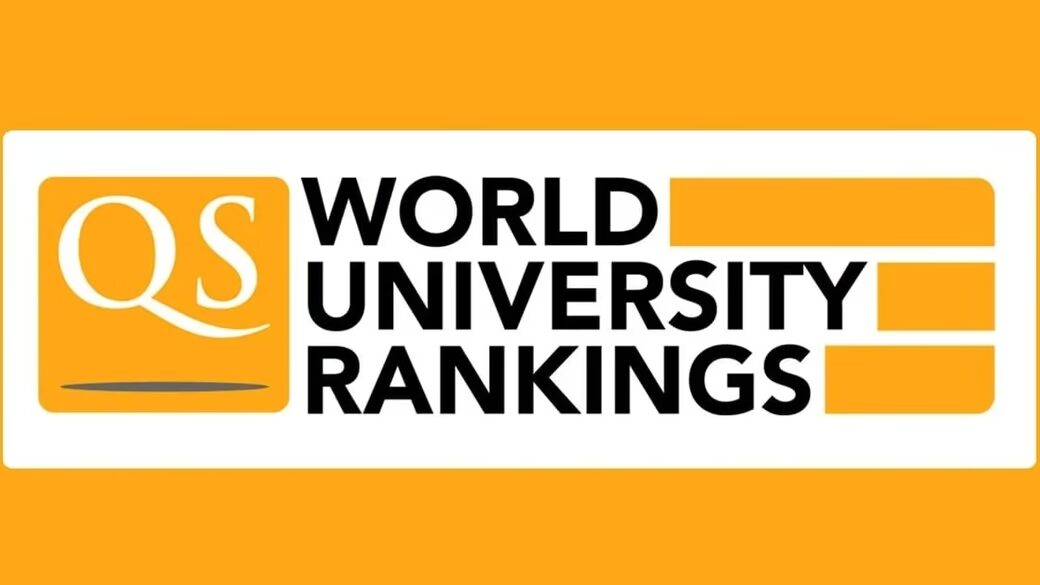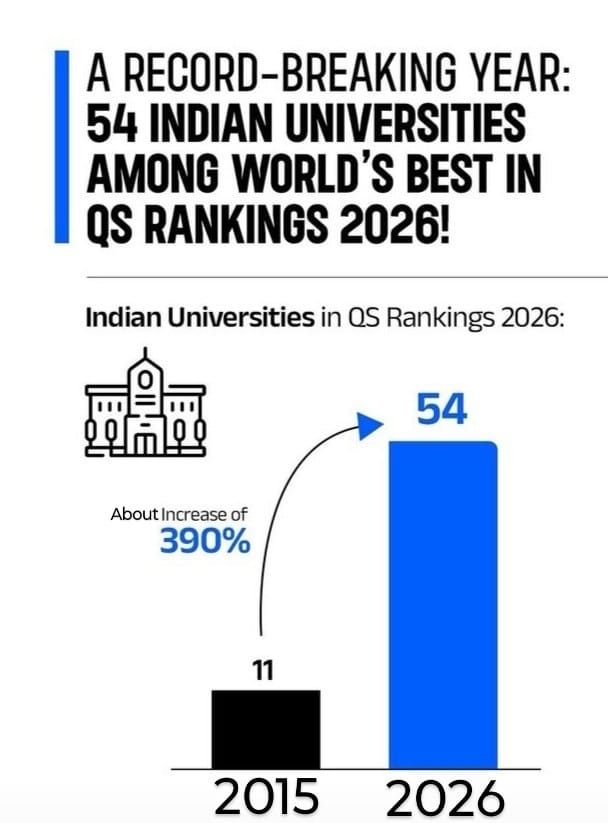
The QS World University Rankings 2026 are out, painting a detailed picture of excellence in education worldwide. All the aforementioned spadework to improve these indicators in India through heavy investments in education, innovation, and research has contributed remarkably to India’s rank in this year’s edition. This is a clear sign of the shift in strategies that Indian institutions have made in upgrading their positions for global competitiveness in higher education.
Here we assess India’s standing in 2026, recognise the major parameters by which QS ranks, and then analyse what this means for students, educators, and policymakers.
ALSO READ- India’s Oil Jackpot Found in the Andaman Sea
What Are the QS World University Rankings?
The QS Rankings are probably one of the most widely known global rankings of universities, looking at how universities perform every year all over the world.
Keeping in mind these highlights:
The QS World University Rankings are compiled by Quacquarelli Symonds (QS), a UK-based higher education analytics firm. QS was founded by Nunzio Quacquarelli in 1990.
More than 1500 universities and more than 100 countries are included in the coverage. Quantitative and qualitative parameters comprise an exhaustive set. Provides rankings on programs, regions, and subjects as well.
Parameters of QS World University Rankings 2026-
The 2026 edition makes use of nine major performance indicators, adapted slightly to cover new trends in world education.
Academic Reputation (30%):
Based on global surveys of academics identifying institutions producing top-quality research and graduates perceived ability across areas.
Employer Reputation (15%):
Originating from surveys of employers using the graduates of universities around the world. Indicates how well universities prepare students for the labour market.
Faculty-Student Ratio (10%):
This dimension evaluates the quality of teaching by assessing the academic staff-to-student ratios. A lower ratio indicates more customised attention.
Citations per Faculty (20%):
Assesses research results and impact by the number of citations received per faculty member.
International Faculty Ratio (5%):
The ratio simulates how attractive a university is to international academic professionals.
International Student Demography (5%):
Therefore shows the extent to which one can bring students from various parts of the earth.
International Research Network (5%):
This is made possible by analysing co-authorship of scholarly articles to demonstrate global collaborative research in terms of the number of papers published.
Employment outcomes (5%):
In this sense, measuring the employability, engagement in entrepreneurship, and social contribution of the university graduates.
QS 2026 Rankings: Highlights-
A total of 54 institutions from India have been ranked in the rankings, of which 12 are IITs. India is at fourth place after America(192), United Kingdom(90) and China(72). Continuing its 14-year streak, the Massachusetts Institute of Technology (MIT) has once again secured the top position as the world’s leading academic institution this year. Also, Eighteen institutions from Pakistan got the position in the ranking.
Top Ten Best Performing Institutions Worldwide:
| Institution | Country | 2026 Rank | 2025 Rank |
|---|---|---|---|
| Massachusetts Institute of Technology (MIT) | United States of America | 1 | 1 |
| Imperial College London | United Kingdom | 2 | 2 |
| Stanford University | United States of America | 3 | 6 |
| University of Oxford | United Kingdom | 4 | 3 |
| Harvard University | United States of America | 5 | 4 |
| University of Cambridge | United Kingdom | 6 | 5 |
| ETH Zurich (Swiss Federal Institute of Technology) | Switzerland | 7 | 7 |
| National University of Singapore (NUS) | Singapore | 8 | 8 |
| UCL (University College London) | United Kingdom | 9 | 9 |
| California Institute of Technology (Caltech) | United States of America | 10 | 10 |
Some Best Performing Indian Institutions:
| S No. | Institution | 2026 Rank | 2025 Rank |
|---|---|---|---|
| 1 | Indian Institute of Technology Delhi (IITD) | 123 | 150 |
| 2 | Indian Institute of Technology Bombay (IITB) | 129 | 118 |
| 3 | Indian Institute of Technology Madras (IITM) | 180 | 227 |
| 4 | Indian Institute of Technology Kharagpur (IITKGP) | 215 | 222 |
| 5 | Indian Institute of Science (IISc) Bangalore | 219 | 211 |
| 6 | Indian Institute of Technology Kanpur (IITK) | 222 | 263 |
| 7 | University of Delhi | 328 | 328 |
| 8 | Indian Institute of Technology Guwahati (IITG) | 334 | 344 |
| 9 | Indian Institute of Technology Roorkee (IITR) | 339 | 335 |
| 10 | Anna University | 465 | 383 |
| 11 | Shoolini University of Biotechnology and Management Sciences | 503 | 587 |
| 12 | Indian Institute of Technology Indore | 556 | 477 |
| 13 | Jawaharlal Nehru University | 558 | 580 |
| 14 | Indian Institute of Technology BHU Varanasi (IIT BHU Varanasi) | 566 | 531 |
What Factors have contributed positively towards the Indian Ranking?

- Firstly, the NEP 2020.
- Interdisciplinary academic research and activities.
- The new autonomy and internationalisation policies have begun yielding fruit.
- Increased R&D Funding: Increasing funding sources, both governmental and private, into laboratories, research centres, and academic publishing. Enhancing visibility in the citation databases.
- Digital Changes: Digitisation in education and artificial intelligence in virtual learning environments and tools have enhanced their further reach and more academic flexibility.
- Academia Partnership: Global companies’ collaborations, internships, and entrepreneurship hubs increased employability scores.
Challenges Still Faced by Indian Institutions-
Yet, although some advances have been made, numerous problems require continued attention:
- Faculty Shortage: Many institutions find it difficult to maintain the cherished levels between teachers and students.
- Infrastructure Gap: There are vast disparities between elite institutions and state universities.
- International Attractiveness: There is a need to work harder to recruit international faculty and students.
- Quality of Publications: While quantity has increased, the quality and rating of research need continuous improvement.
How Students Can Use These Rankings-
- Worldwide Comparison: Manages comparison of institutions to undergraduate, postgraduate, or PhD programs from a global perspective.
- Program Strengths: Subject-wise ranking in the area of engineering, humanities, law, or medicine.
- Scholarship Considerations: Often, the high-ranking institution offers better funding.
- Career Planning: Employer reputation scores match job readiness.
Policy Takeaways and Recommendations-
Internationalisation:
- Streamline visa and recruitment procedures for external faculty and students.
- Bilateral arrangements should be created to facilitate easy movement for academic mobility.
- National campaigns should be initiated to attract students to Indian universities.
- Scholarships and other incentives should be provided to international students and faculty for cultural and academic exchange.
Research Incentives:
- Funding and awards for the promotion of high-impact publications to international recognition.
- Set up national awards for young researchers and interdisciplinary collaboration.
- Targeted funding should be established to encourage publication in highly prestigious international journals.
- Universities should be rewarded in terms of institutional bonuses or ranking on the basis of research efficiency and impact factors.
Autonomy and Accountability:
- Universities should have greater autonomy in curricular affairs and operational autonomy.
- Encourage flexible course structures, keeping in mind industry and research trends.
- Centres for monitoring academic delivery should be set up so that performance can be easily tracked.
- The universities should be granted autonomy to manage themselves under clean audits and peer reviews.
Promote Public-Private Partnerships:
- Encourage the industry to get involved in curriculum development and establish innovation hubs.
- Co-create syllabi about the industry and develop modules for practical training.
- Research chairs and startup incubation centres should be developed with corporate funding.
- Communication between academia and industry should be fostered continuously to align expectations and achievements.
Conclusion: Towards a Bright Future-
QS World University Rankings 2026 are very promising indicators for Indian higher education. Indian higher education, however, has threats to tackle. But one glaring reality is that this country will be at a much more significant global countenance in the years to come. It should take on this momentum for quality, access, and relevance to global citizenry as the education ecosphere changes.
India will not only ascend in the Fortune but also bring to the world map a new identity of itself entirely in the academic realm.
